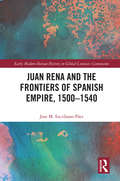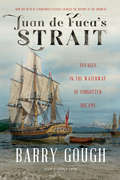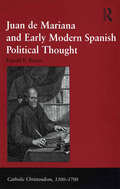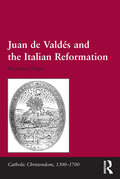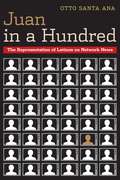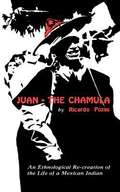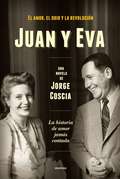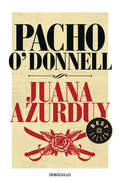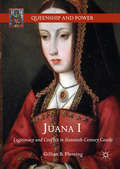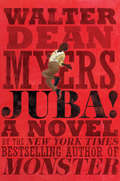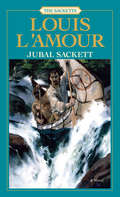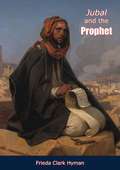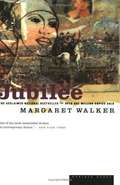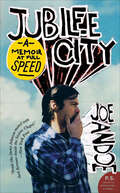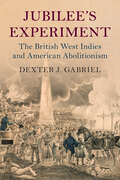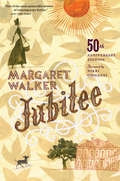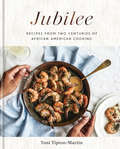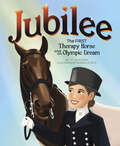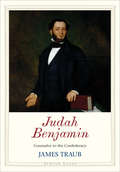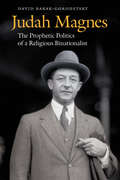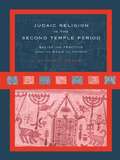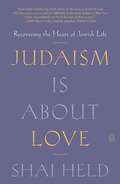- Table View
- List View
Juan Rena and the Frontiers of Spanish Empire, 1500–1540 (Early Modern Iberian History in Global Contexts)
by Jose M. Escribano-PáezThis book explores the political construction of imperial frontiers during the reigns of Ferdinand the Catholic and Charles V in the Iberian Peninsula and the Mediterranean. Contrary to many studies on this topic, this book neither focuses on a specific frontier nor attempts to provide an overview of all the imperial frontiers. Instead, it focuses on a specific individual: Juan Rena (1480–1539). This Venetian clergyman spent 40 years serving the king in several capacities while travelling from the Maghreb to northern Spain, from the Pyrenees to the western fringes of the Ottoman Empire. By focusing on his activities, the book offers an account of the Spanish Empire’s frontiers as a vibrant political space where a multiplicity of figures interacted to shape power relations from below. Furthermore, it describes how merchants, military officers, nobles, local elites and royal agents forged a specific political culture in the empire’s liminal spaces. Through their negotiations and cooperation, but also through their competition and clashes, they created practices and norms in areas like cross-cultural diplomacy, the making of the social fabric, the definition of new jurisdictions, and the mobilization of resources for war.
Juan de Fuca's Strait
by Barry GoughThe tale begins in sixteenth-century Venice, when explorer Juan de Fuca encountered English merchant Michael Lok and relayed a fantastic story of a marine passageway that connected the Pacific and Atlantic Oceans. This tale would be the catalyst for centuries of dreaming, and exacerbate English and Spanish rivalry.The search for the fabled Northwest Passage inspired explorers to seek out fame, adventure, knowledge and riches. Likewise, the empires of Spain and Great Britain were impelled by the hopes of finding a naval trade route that would connect Europe to Asia, thus securing their dominance over the other as an economic power. The story of the Northwest Passage is one of significant figures and great empires, jostling for a distant corner of North America.Gough provides meticulously researched insight, delving into diplomatic records, narratives of explorers and commercial aspirants, legal affidavits and court records to illuminate the journeys of Martin Frobisher, James Cook, Francis Drake, Manuel Quimper, José María Narváez, George Vancouver and Juan Francisco de la Bodega y Quadra, among others.A sea venture tied up with piracy, political loyalty and betrayal, all bound up in a web of international intrigue, Juan de Fuca's Strait is an indispensable contribution to the history of discovery on the Northwest Coast.
Juan de Mariana and Early Modern Spanish Political Thought (Catholic Christendom, 1300-1700)
by Harald E. BraunThe Jesuit Juan de Mariana (1535-1624) is one of the most misunderstood authors in the history of political thought. His treatise De rege et regis institutione libri tres (1599) is dedicated to Philip III of Spain. It was to present the principles of statecraft by which the young king was to abide. Yet soon after its publication, Catholic and Calvinist politiques in France started branding Mariana a regicide. De rege was said to empower the private individual to kill a legitimate king. Its 'pernicious doctrines' were blamed for the murder of Henry IV in 1610, and it was burned at the order of the parlement of Paris. Modern historians have tended to build on this interpretation and consider De rege a stepping stone towards modern pluralist and democratic thought. Nothing could be further from the truth. The notion of Mariana as an uncompromising theorist of resistance is in fact based on the distorted reading of a few select sentences from the first book of the treatise. This study offers a radical departure from the old view of Mariana as an early modern constitutionalist thinker and advocate of regicide. Thorough analysis of the text as a whole reveals him to be a shrewd and creative operator of political language as well as a champion of the church and bishops of Castile. The argument as a whole is informed by a Catholic-Augustinian view of human nature. Mariana's bleak, at times downright cynical view of man imparts focus and coherence to a text that challenges well established terminological boundaries and political discourses. In the first instance, his deeply pessimistic appraisal of human virtue justifies his disregard of positive law. He is thus able to mould diverse elements extracted from Roman and canon law, scholastic theology and humanist literature into a deliberately equivocal discourse of reason of state. Finally, this secular interpretation of the world of politics is cleverly yoked to a thoroughly clerical agenda of reform. In fact, reason of state is made to propagate an episcopal monarchy. De rege is exceptional in that it strings together a curious scholastic theory of the origins of society, a conservative ideology of absolute monarchy and a breathtakingly radical vision of theocratic renewal of Spanish government and society. Juan de Mariana and Early Modern Political Thought elucidates the differentiated nature of political debate in Habsburg Spain. It confirms the complexity of Spanish political life in the later sixteenth and early seventeenth century. Complementing recent work on Catholic political thought, the European reception of Machiavelli, and Spanish Habsburg government, this study offers a more complete and holistic picture of early modern Spanish political culture.
Juan de Valdés and the Italian Reformation (Catholic Christendom, 1300-1700)
by Massimo FirpoJuan de Valdés played a pivotal role in the febrile atmosphere of sixteenth-century Italian religious debate. Fleeing his native Spain after the publication in 1529 of a book condemned by the Spanish Inquisition, he settled in Rome as a political agent of the emperor Charles V and then in Naples, where he was at the centre of a remarkable circle of literary and spiritual men and women involved in the religious crisis of those years, including Peter Martyr Vermigli, Marcantonio Flaminio, Bernardino Ochino and Giulia Gonzaga. Although his death in 1541 marked the end of this group, Valdés’ writings were to have a decisive role in the following two decades, when they were sponsored and diffused by important cardinals such as Reginald Pole and Giovanni Morone, both papal legates to the Council of Trent. The most famous book of the Italian Reformation, the Beneficio di Cristo, translated in many European languages, was based on Valdés’ thought, and the Roman Inquisition was very soon convinced that he had ’infected the whole of Italy’. In this book Massimo Firpo traces the origins of Valdés’ religious experience in Erasmian Spain and in the movement of the alumbrados, and underlines the large influence of his teachings after his death all over Italy and beyond. In so doing he reveals the originality of the Italian Reformation and its influence in the radicalism of many religious exiles in Switzerland and Eastern Europe, with their anti-Trinitarians and finally Socinian outcomes. Based upon two extended essays originally published in Italian, this book provides a full up-dated and revised English translation that outlines a new perspective of the Italian religious history in the years of the Council of Trent, from the Sack of Rome to the triumph of the Roman Inquisition, reconstructing and rethinking it not only as a failed expansion of the Protestant Reformation, but as having its own peculiar originality. As such it will be welcomed by all scholars wishin
Juan in a Hundred: The Representation of Latinos on Network News
by Otto Santa AnaLatinos constitute the fastest-growing and largest ethnic minority in the United States, yet less than one percent of network news coverage deals with Latinos as the focus of a story. Out of that one percent, even fewer stories are positive in either content or tone. Author of the acclaimed Brown Tide Rising: Metaphors of Latinos in Contemporary American Public Discourse, Otto Santa Ana has completed a comprehensive analysis of this situation, blending quantitative research with semiotic readings and ultimately applying cognitive science and humanist theory to explain the repercussions of this marginal, negative coverage. Santa Ana's choice of network evening news as the foundation for Juan in a Hundred is significant because that medium is currently the single most authoritative and influential source of opinion-generating content. In his 2004 research, Santa Ana calculated that among approximately 12,000 stories airing across four networks (ABC, CBS, CNN, NBC), only 118 dealt with Latinos, a ratio that has remained stagnant over the past fifteen years. Examining the content of the stories, from briefs to features, reveals that Latino-tagged events are apparently only broadcast when national politics or human calamity are involved, and even then, the Latino issue is often tangential to a news story as a whole. On global events involving Latin America, U.S. networks often remain silent while BBC correspondents prepare fully developed, humanizing coverage. The book concludes by demonstrating how this obscurity and misinformation perpetuate maligned perceptions about Latinos. Santa Ana's inspiring calls for reform are poised to change the face of network news in America.
Juan the Chamula: An Ethnological Re-creation of the Life of a Mexican Indian
by Lysander Kemp Ricardo PozasThis book concerns an indigenous group of Tzotzil-speaking Indians living in the mountain highlands in the state of Chiapas in southern Mexico. It has been recognized as one of the most skillful handlings of Indian themes in Mexican literature.
Juan y Eva: El amor, el odio y la revolución. La historia de amor jamás contada
by Jorge CosciaEn palabras del autor: "Esa historia de amor fue el big bang de unmovimiento político cuyas consecuencias aún perduran con inusitadovigor". La relación amorosa entre Juan Domingo Perón y Eva Duarte fue a menudoomitida en los análisis tradicionales de la historia argentina. Estamaravillosa novela que escribió Jorge Coscia está basada en los hechosreales del período en el que Perón y Evita consolidaron su romance,entre enero de 1944 -cuando un terremoto destruyó la ciudad de San Juany en la colecta por los damnificados se encuentran por primera vez laactriz de radio y un coronel de la revolución de 1943- y la madrugadadel 18 de octubre de 1945. Por eso, El texto funciona también como undocumento histórico sorprendente y rescata la perspectiva humana de lospersonajes, sus temores, sus emociones.
Juana Azurduy
by Pacho O'DonnellLa figura fascinante de Juana Azurduy, guerrera del Alto Perú, heroína de la independencia, fue largamente relegada por la historia oficial. Pacho O'Donnell reivindica aquí su lucha, llena de coraje, astucia y entrega. En este libro Pacho O'Donnell rescata a una figura injustamente postergada: la de Juana Azurduy. Repasar la vida de la heroína independentista que combatió en el Alto Perú y que entonces alcanzó el grado de teniente coronela (no hace mucho fue ascendida a generala) cumple con una doble reivindicación. En primer lugar la de las mujeres que, armas en mano, combatieron por nuestra libertad a la par de los hombres. Su figura desmiente el rol secundario que pretendió atribuirles la machista historia oficial, que las retrató dedicadas a coser banderas, donar alhajas y, sobre todo, esperar pacientemente el regreso de sus esposos del campo de batalla. Por el otro lado, O'Donnell pone de relieve la valiente acción de los caudillos altoperuanos, a quienes aún se les debe un merecido reconocimiento por su fundamental aporte a la emancipación de nuestros pueblos. El coraje, la astucia y la generosidad con los que Juana Azurduy llevó adelante la lucha contra el ejército realista no solo son los valores que realzan la proeza independentista, sino aquellos que nuestra Patria hoy nos reclama para superar las épocas de crisis.
Juana I: Legitimacy And Conflict In Sixteenth-century Castile (Queenship and Power)
by Gillian B. FlemingThis book examines the deep and lengthy crisis of legitimacy triggered by the death of Prince Juan of Castile and Aragon in 1497 and the subsequent ascent of Juana I to the throne in 1504. Confined by historiography and myth to the madwoman’s attic, Juana emerges here as a key figure at the heart of a period of tremendous upheaval, reaching its peak in the war of the Comunidades, or comunero uprising of 1520–1522. Gillian Fleming traces the conflicts generated by the ambitions of Juana’s father, husband and son, and the controversial marginalisation and imprisonment of Isabel of Castile’s legitimate heir. Analysing Juana’s problems and strategies, failures and successes, Fleming argues that the period cannot be properly understood without taking into account the long shadow that Juana I cast over her kingdoms and over a crucial period of transition for Spain and Europe.
Juana Lucero
by Augusto D'HalmarEn 1902 se publicó La Lucero (Los Vicios de Chile). Más tarde, La Lucero pasó a llamarse simplemente Juana Lucero, obra que se transformó en un hito en la literatura nacional. Por una parte se trataba de la expresión más directa de la influencia de Emile Zolá en la producción literaria de la época, por otra se trataba de la obra a la que la historia le otorgaría el rol de precursora del realismo en Chile. Novela costumbrista chilena, ambientada en Santiago. Juana Lucero, una adolescente, hija de una costurera muy humilde y un diputado que brilla por su ausencia, queda huérfana y debe aprender a vivir la vida sola. Tras la muerte de la madre es víctima de abusos, menosprecio en su condición de mujer y obrera y las personas que la rodean la utilizan y engañan. Las circunstancias la conducen a un abismo del que no sabe como salir, y acepta la prostitución como alternativa. La trama transcurre en el Barrio Yungay, a principios del siglo XX.
Juba!: A Novel
by Walter Dean MyersIn New York Times bestselling author Walter Dean Myers's last novel, he delivers a gripping story based on the life of a real dancer known as Master Juba, who lived in the nineteenth century. <P><P>This engaging historical novel is based on the true story of the meteoric rise of an immensely talented young black dancer, William Henry Lane, who influenced today's tap, jazz, and step dancing. With meticulous and intensive research, Walter Dean Myers has brought to life Juba's story.The novel includes photographs, maps, and other images from Juba's time and an afterword from Walter Dean Myers's wife about the writing process of Juba!red in the North and sent down South as slaves. England offers freedoms that Juba could only dream of in the States, and returning home may prove a dangerous decision. <P><P>This novel is based on a true story, the intricacies of Juba's meteoric rise as an explosive young black dancer brought to life by Walter Dean Myers through meticulous and intensive research.
Jubal Sackett (Sacketts #4)
by Louis L'AmourIn Jubal Sackett, the second generation of Louis L'Amour's great American family pursues a destiny in the wilderness of a sprawling new land. Jubal Sackett's urge to explore drove him westward, and when a Natchez priest asks him to undertake a nearly impossible quest, Sackett ventures into the endless grassy plains the Indians call the Far Seeing Lands. He seeks a Natchez exploration party and its leader, Itchakomi. It is she who will rule her people when their aging chief dies, but first she must vanquish her rival, the arrogant warrior Kapata. Sackett's quest will bring him danger from an implacable enemy . . . and show him a life--and a woman--worth dying for.From the Paperback edition.
Jubal and the Prophet
by Frieda Clark Hyman Bernard KrigsteinJubal is the son of an important priest in the First Temple; the prophet is Jeremiah; and the time is Jerusalem under siege by the Babylonian Army. Jubal’s father leads the struggle against Babylon. Jeremiah pleads for submission to Babylon.Jubal, of course, would rather follow his father, but in spite of this natural desire, he is convinced by the message and personality of Jeremiah. His struggles lead him directly into adventure. With his friend Ezra he outwits the commander of the gates of Jerusalem, the jailer who would torture the prophet, and then this boy of courage and wisdom fights heroically in the final battle.All this, and more is the theme of the book, a story that is filled with constant action, colorful background and human as well as spiritual emotion.“Jeremiah was the most disquieting of all the prophets. To this day there are some who call him traitor. If, however, a prophet is—as I believe he is—God’s instrument, a man who speaks because a Power greater than he compels him to speak, there can be no question about Jeremiah’s integrity. Nevertheless, the human being is also present; and it is the tension between the prophet’s function as God’s mouthpiece, and his humanity as a patriot, that constitutes the theme of this book: he must condemn his people and his country even while he loves them.”—Frieda Clark Hyman
Jubilee
by Margaret WalkerHistorical novel exploring the struggles of a Black family freed from slavery in Civil War era Georgia..
Jubilee City: A Memoir at Full Speed
by Joe AndoeJoe Andoe is an internationally exhibited painter. His work, hailed by The New Yorker as "cowboy noir with a fashionista twist," is in the collections of the Museum of Fine Arts in Boston, the Whitney Museum of Art in New York, and countless other locations. He is a father. He is a writer. He is sober. That's now.Once upon a time, though, way back in the '70s, Joe Andoe was a delinquent bad boy growing up wild in Tulsa, Oklahoma—drinking, drugging, and driving too fast down a dead-end road. He was one car crash, one overdose away from head-on disaster. His art saved him.A life story told in discrete, arresting snapshots of despair, resilience, creativity, and hope, Joe Andoe's raw, vivid, and utterly original memoir is as striking as his painting. With echoes of Jim Carroll poetic insight and Charles Bukowski grit, yet still uniquely the artist's own, Andoe's literary portrait of his time to date on earth is as powerful as a heavyweight's hook and as spellbinding as a major crack-up on the opposite side of the highway. It is an important work of curiosity and grandiosity; a testament to a young man's resilience and genius and luck that enabled him to survive a life lived wildly out of control; an unparalleled adventure, a rocket ride from the sordid depths of self-destruction to the glorious pinnacles of…Jubilee City
Jubilee Trail
by Gwen BristowIn a moment of ecstasy, Garnet Cameron decides to leave New York and go with Oliver Hale to the far-off place called California. Historical romance set in the 1840s.
Jubilee Trail: A Novel
by Gwen BristowA willful New York debutante travels the rugged Great Plains for a future in the flourishing American West in this New York Times bestseller. Charting the trail across the Great Plains from New York City to the Mexican territory of California, a headstrong couple embarks on a new life in this classic work of historical fiction as unforgiving, moving, and unpredictable as the frontier. A recent finishing school graduate, eighteen-year-old Garnet Cameron is desperate for direction. Too driven for the restrictive manners of the upper class, Garnet is naturally drawn to Oliver Hale, a frontier trader. Unlike the men Garnet is accustomed to, Oliver treats her as his equal and respects her independence. His tales of adventure on the plains thrill her. And his proposal of marriage is accepted. Garnet eagerly grabs hold of the promise and prospect of an exciting future, only to discover how ill-prepared she is for the punishing landscape of the Jubilee Trail and the even harsher realities of human nature. Adapted into a feature film, Jubilee Trail is a classic novel of a woman in the West, beloved not only for the rebelliousness and resilience of its heroine, but for its authenticity, grand sweep, unsparing intimacy, and honest portrayal of the survivors and victims—as well as the victors and villains—of a defiant American wilderness.
Jubilee's Experiment: The British West Indies and American Abolitionism (Slaveries since Emancipation)
by Dexter J. GabrielDexter J. Gabriel's Jubilee's Experiment is a thorough examination of how the emancipated British Caribbean colonies entered into the debates over abolition and African American citizenship in the US from the 1830s through the 1860s. It analyzes this public discourse, created by black and white abolitionists, and African Americans more generally in antebellum America, as both propaganda and rhetoric. Simultaneously, Gabriel interweaves the lived experiences of former slaves in the West Indies – their daily acts of resistance and struggles for greater freedoms – to further augment but complicate this debate. An important and timely intervention, Jubilee's Experiment argues that the measured success of former slaves in the West Indies became a crucial focal point in the struggle against slavery in antebellum North America.
Jubilee: And Other Essays On Life And Literature
by Margaret WalkerThe bestselling classic about a mixed-race child in the Civil War-era South that &“chronicles the triumph of a free spirit over many kinds of bondage&” (TheNew York Times Book Review). Jubilee tells the true story of Vyry, the child of a white plantation owner and his black mistress. Vyry bears witness to the antebellum South in both its opulence and its brutality, its wartime ruin, and the promises of Reconstruction. Weaving her own family&’s oral history with thirty years of research, Margaret Walker brings the everyday experiences of slaves to light in a novel that churns with the hunger, the hymns, the struggles, and the very breath of American history. &“A revelation.&”—Milwaukee Journal Includes a foreword by Nikki Giovanni
Jubilee: Recipes from Two Centuries of African American Cooking: A Cookbook
by Toni Tipton-MartinMore than 100 recipes that paint a rich, varied picture of the true history of African American cooking—from a James Beard Award–winning food writer NAMED ONE OF FALL&’S BEST COOKBOOKS BY The New York Times • Bon Appétit • Eater • Food & Wine • Kitchn • Chowhound Throughout her career, Toni Tipton-Martin has shed new light on the history, breadth, and depth of African American cuisine. She&’s introduced us to black cooks, some long forgotten, who established much of what&’s considered to be our national cuisine. After all, if Thomas Jefferson introduced French haute cuisine to this country, who do you think actually cooked it? In Jubilee, Tipton-Martin brings these masters into our kitchens. Through recipes and stories, we cook along with these pioneering figures, from enslaved chefs to middle- and upper-class writers and entrepreneurs. With more than 100 recipes, from classics such as Sweet Potato Biscuits, Seafood Gumbo, Buttermilk Fried Chicken, and Pecan Pie with Bourbon to lesser-known but even more decadent dishes like Bourbon & Apple Hot Toddies, Spoon Bread, and Baked Ham Glazed with Champagne, Jubilee presents techniques, ingredients, and dishes that show the roots of African American cooking—deeply beautiful, culturally diverse, fit for celebration.
Jubilee: The First Therapy Horse and an Olympic Dream
by KT JohnstonLis Hartel became paralyzed after contracting polio in 1944. Her dreams of riding horses and competing in the sport of dressage were shattered. After months in the hospital, doctors told her she’d never ride again. Lis tried anyway. How do you stay on a horse without using your legs? How do you give the subtle cues needed in dressage with limited mobility? With hard work—and an unlikely horse named Jubilee. After years of training together and creating a new way of communicating, Lis and Jubilee danced into the competition ring, and eventually all the way to the Olympics. Lis Hartel was the first woman with a disability ever to win an Olympic medal, and the first woman to stand equally beside men on the Olympic winners' podium in any sport.
Judah Benjamin: Counselor to the Confederacy (Jewish Lives)
by James TraubA moral examination of one of the first Jewish senators, confidante to Jefferson Davis, and champion of the cause of slavery Judah P. Benjamin (1811–1884) was a brilliant and successful lawyer in New Orleans, and one of the first Jewish members of the U.S. Senate. He then served in the Confederacy as secretary of war and secretary of state, becoming the confidant and alter ego of Jefferson Davis. In this new biography, author James Traub grapples with the difficult truth that Benjamin, who was considered one of the greatest legal minds in the United States, was a slave owner who deployed his oratorical skills in defense of slavery. How could a man as gifted as Benjamin, knowing that virtually all serious thinkers outside the American South regarded slavery as the most abhorrent of practices, not see that he was complicit with evil? This biography makes a serious moral argument both about Jews who assimilated to Southern society by embracing slave culture and about Benjamin himself, a man of great resourcefulness and resilience who would not, or could not, question the practice on which his own success, and that of the South, was founded.
Judah Magnes: The Prophetic Politics of a Religious Binationalist
by David Barak-GorodetskyThis comprehensive intellectual biography of Judah Magnes—the Reform rabbi, American Zionist leader, and inaugural Hebrew University chancellor—offers novel analysis of how theology and politics intertwined to drive Magnes&’s writings and activism—especially his championing of a binational state—against all odds. Like a prophet unable to suppress his prophecy, Magnes could not resist a religious calling to take political action, whatever the cost. In Palestine no one understood his uniquely American pragmatism and insistence that a constitutional system was foundational for a just society. Jewish leaders regarded his prophetic politics as overly conciliatory and dangerous for negotiations. Magnes&’s central European allies in striving for a binational Palestine, including Martin Buber, credited him with restoring their faith in politics, but they ultimately retreated from binationalism to welcome the new State of Israel. In candidly portraying the complex Magnes as he understood himself, David Barak-Gorodetsky elucidates why Magnes persevered, despite evident lack of Arab interest, to advocate binationalism with Truman in May 1948 at the ultimate price of Jewish sovereignty. Accompanying Magnes on his long-misunderstood journey, we gain a unique broader perspective: on early peacemaking efforts in Israel/Palestine, the American Jewish role in the history of the state, binationalism as political theology, an American view of binationalism, and the charged realities of Israel today.
Judaic Religion in the Second Temple Period: Belief and Practice from the Exile to Yavneh
by Lester L. GrabbeThe developments in Judaism which occurred during the Second Temple period (c. 550 BC to 100 AD) were of great importance for the nature of Jewish religion in later centuries, yet few studies have examined the era in full. Now Lester L. Grabbe's lucid and accessible volume provides a much-needed encyclopedic study and holistic interpretation of the period.Topics examined include:* views about God and the spirit world* the temple and priesthood* scripture and synagogue* the main religious sects and revolutionary movements* eschatology and messianism* magic and predicting the future* religion in the Jewish diaspora* converts and 'Godfearers'.With an extensive, up-to-date bibliography, plus numerous helpful cross-references, summaries and syntheses, this book is essential reading for scholars and students of the history of Jewish religion. It will also be of great value as a reference tool.
Judaism Is About Love: Recovering the Heart of Jewish Life
by Shai HeldA profound, startling new understanding of Jewish life, illuminating the forgotten heart of Jewish theology and practice: love.A dramatic misinterpretation of the Jewish tradition has shaped the history of the West: Christianity is the religion of love, and Judaism the religion of law. In the face of centuries of this widespread misrepresentation, Rabbi Shai Held—one of the most important Jewish thinkers in America today—recovers the heart of the Jewish tradition, offering the radical and moving argument that love belongs as much to Judaism as it does to Christianity. Blending intellectual rigor, a respect for tradition and the practices of a living Judaism, and a commitment to the full equality of all people, Held seeks to reclaim Judaism as it authentically is. He shows that love is foundational and constitutive of true Jewish faith, animating the singular Jewish perspective on injustice and protest, grace, family life, responsibilities to our neighbors and even our enemies, and chosenness.Ambitious and revelatory, Judaism Is About Love illuminates the true essence of Judaism—an act of restoration from within.
